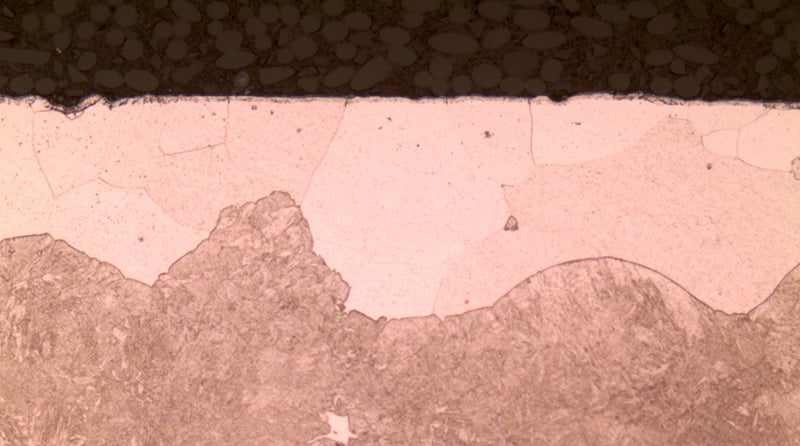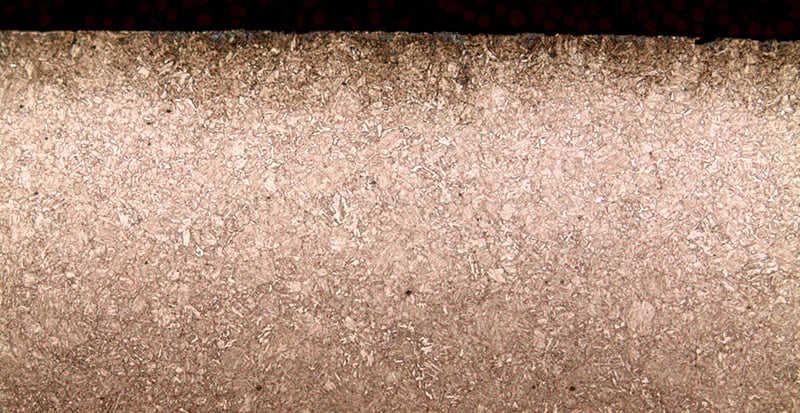Strengthening steel parts via heat treatment comes with its share of risks.
One such risk is decarburization, which can weaken steel parts and put them at greater risk of failure during their service. There’s even an industry standard —ASTM E1077— dedicated to decarburization depth measurement.
Preventing decarburization in steel requires metallurgists and their customers to pay attention to the details.
What happens during decarburization?
Decarburization occurs during the interaction between the carbon atoms in steel and the atmosphere of an endothermic atmosphere furnace. It’s essentially the opposite of carburization—carbon is drawn out of ferrous material rather than put into it.
It happens when carbon content inside the furnace is not properly controlled. When the conditions aren’t right, carbon atoms in a steel part diffuse outward through its surface. Decarburization can occur during manufacturing prior to heat treatment and also as a result of heat treatment processes.
Parts where decarburization is often observed prior to heat treatment include investment casting parts, forgings and castings and medium-carbon steels derived from hot-rolled barstock.
Investment castings can have significant decarburization stemming from sub-par conditions in foundry equipment, but this can be reversed during heat treatment with a carbon restoration.
For forgings, castings and barstock, decarburization can either be machined off or fixed via carbon restoration.
What can go wrong?
Just as adding carbon to steel makes it stronger, removing it makes it weaker.
The surface of a part is most affected during decarburization. Because carbon is drawn out through the surface, the result is a part with less carbon content near the surface compared to the core.
With less carbon at the surface, a part becomes less resistant to stress. Parts that encounter extreme rotating or alternating forces —structural bolts, for example— are prone to fail if decarburization occurs. Decarburization also presents added quench cracking risks for parts made of more hardenable alloys.
Usually, decarburization during heat treatment occurs when carbon is not adequately controlled in the furnace. Carbon control isn’t easy, so it’s critical that furnaces are always monitored and regularly calibrated to ensure peak performance.
Decarburization test methods
Because decarburization saps a part of its strength, metallurgists can measure that loss using some of the same hardness testing methods used to measure the part’s surface hardness.
For example, the depth and extent of decarburization can be determined by using a Knoop microhardness test. Hardness is measured at greater and greater depths perpendicular to the part surface until a constant hardness is observed.
Decarburization depth measurement can also be conducted with metallographs. Metallurgists use these powerful microscopes to observe and measure how deep from the surface carbon loss has occurred.
Preventing decarburization
In some cases, the damage done by decarburization can be undone via a carbon restore. This involves putting a part back into the furnace with the atmosphere calibrated to replace the carbon that was previously drawn out.
But it’s easier and less costly to prevent decarburization, and both heat treaters and their customers can work together to see it through.
For manufacturers, it’s important to know the parts at high risk of decarburization. Investment castings and, to a lesser extent, hot-rolled barstock parts often have decarburization present prior to heat treatment. Millstock present on these parts prior to heat treatment should be machined off to help avoid decarburization.
Then, the burden shifts to heat treaters. Ensuring correct calibration and control of heat treating equipment is critical.
That’s where an outsourcing partnership can do a world of good. At Paulo, we combine top-of-the-line equipment and leading expertise with a computerized process control system we built ourselves. It monitors every aspect of a job and lets our experts see furnace conditions in real time.
With decades of experience on heat treatment projects of all types and sizes, you can be sure your parts are made better by the best in the business. Contact a metallurgist if you want to know more about preventing decarburization. You can also learn more about how an outsourcing partnership can enhance heat treating risk management by downloading our free guide.





